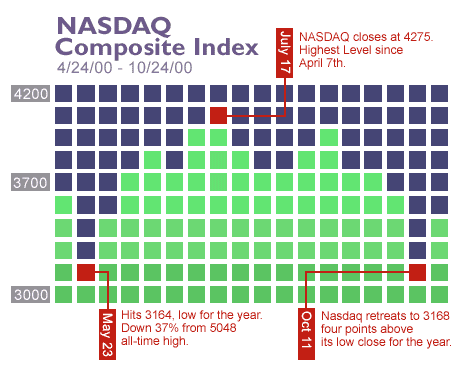|
It's dot.com, not dot.bomb
|
 |
October 24, 2000: 9:13 a.m. ET
The wave has crashed, but that doesn't make tech investing the new pariah
By Staff Writer M. Corey Goldman
|
NEW YORK (CNNfn) - First, the bad news: the era of outrageous valuations for dot.com companies with no realistic plan for making money is over.
Now, the good news: the era of outrageous valuations for dot.com companies with no realistic plan for making money is over.
Shareholders in now deceased Internet companies may be licking their wounds but for future dot.com investors, the playing field just got a lot narrower.
Despite the gut-wrenching ups and downs that have seen the Nasdaq composite index shed more than 20 percent of its value in the past eight months, despite the ever-growing list of dot.coms that are laying off staff or calling it quits, despite the "I told you so" sentiment among, well, everybody, the new economy is still very much alive and well.

The shakeout of the dot.com world, according to the people who work in it, fund it, analyze it and invest in it, has been the best thing that ever could have happened. The days of venture capital firms funding seven different pet supply Web sites may be gone, but a host of different Internet technologies are still out there getting funding and waiting for an IPO.
This is still the new economy, they say. No, the Internet has not replaced television. No, not everyone wants to order groceries online. No, you cannot determine the exact color of a car's upholstery on a computer screen. And yes, few companies out there are willing to hand over their buying and selling to a B2B company.
At least not yet.
This is not 1993...
"The new economy is very, very much alive and well," said Bruce Steinberg, chief economist with Merrill Lynch and one of the biggest proponents of tech stocks and their lofty valuations. "This is that healthy shakeout of Internet companies that many of us have been talking about for months. Now it's time to sift through the rubble and see what's left standing -- and what will grow in its place."
To put it in perspective, think back to 1993. A laptop computer barely fit on one's lap. A mobile phone was something wealthy people strapped to their backs. E-mail was a text-only novelty used at large companies for internal messaging. And Palm Pilots were hard to come by.
 We've obviously come a long way. While the financial media have had a field day proclaiming the end of the excessive dot.com era, thousands of companies involved in everything from speeding up Internet access to using new kinds of software to boost production lines and productivity are still hard at work. We've obviously come a long way. While the financial media have had a field day proclaiming the end of the excessive dot.com era, thousands of companies involved in everything from speeding up Internet access to using new kinds of software to boost production lines and productivity are still hard at work.
"It's like someone pulled out a big two-by-four and said, 'Remember, it's about fundamentals,'" said Phil Summe, a principal at Flatiron Partners, a New York-based venture capital firm that's invested more than $400 million in dot.com companies. "Very quickly, people have become a lot more realistic about what makes a great business on the Internet. It will be a lesson a lot of people will internalize: concepts don't pay the bills."
For people who invested in companies such as APB.com, PlanetRx.com (PLRX: Research, Estimates), DrKoop.com (KOOP: Research, Estimates), eGreetings.com (EGRT: Research, Estimates) and others, that kind of talk is somewhat cheap. Since March, many of them have seen their stock fall by as much as 80 percent or more, forcing them to scale back operations, cut back on advertising and promotion or, in some cases, completely abandon their businesses.
A business model that's profitable?
Many others are cutting staff. Internet shipping and postage company Stamps.com Inc. Monday announced plans to cut 40 percent of its work force in an effort to lower costs. A report from outplacement firm Challenger, Gray & Christmas Inc. also released Monday says dot.com layoffs increased 18 percent to 5,677 by Oct. 20 from 4,805 in September.
But for all the examples of failure, there are just as many companies that see success beyond the dot.com shakeout. Despite recent pain, business plans are still flowing into Flatiron and other VC firms at a frenetic pace.
 Outerforce Systems Inc. and Return Path Inc. are two companies that Flatiron has funded just in the past month. Outerforce Systems makes software that enables content providers to manage all the content they provide. They got $8 million in financing. And Return Path is setting up a network that shares information when a customer changes his or her email address - ensuring that companies such as E*Trade (EGRP: Research, Estimates) and Amazon.com (AMZN: Research, Estimates) keep better track of their clients. They also got $8 million in financing. Outerforce Systems Inc. and Return Path Inc. are two companies that Flatiron has funded just in the past month. Outerforce Systems makes software that enables content providers to manage all the content they provide. They got $8 million in financing. And Return Path is setting up a network that shares information when a customer changes his or her email address - ensuring that companies such as E*Trade (EGRP: Research, Estimates) and Amazon.com (AMZN: Research, Estimates) keep better track of their clients. They also got $8 million in financing.
Even the existing dot.com behemoths that everyone has come to hate -- Amazon, Yahoo! Inc. (YHOO: Research, Estimates), American Online, Inc. (AOL: Research, Estimates), Priceline.com (PCLN: Research, Estimates), eBay (EBAY: Research, Estimates) -- have business models and revenue targets that some Wall Street analysts believe can and will make them profitable and justify their stock valuations.
Dan Ries, an analyst with C.E. Unterberg, Towbin, last week released a 35-page report outlining 10 leading dot.com e-tailers that - get this - have business plans that can generate positive revenue. The companies included, among others, Amazon, eBay, Etoys (ETYS: Research, Estimates), Priceline.com and 1-800 Contacts (CTAC: Research, Estimates).
Yes Virginia, e-tailers can make money
The way Ries figures it, for each new customer order, Amazon spends roughly $17.30. It makes about $12 in gross profit per order, leaving the company with a $5.30 customer acquisition cost, or CAC. But on repeat orders, Amazon dishes out much less -- about $7.50 per customer in sales and marketing spending - but makes the same $12 gross profit. That gives it a gross profit margin per order of $4.50, meaning it is recouping the cost of finding and retaining its customers in the first place.
"If Amazon can make money, or at least have a business plan that is capable of making money, then so can a lot of other e-tailers, and a lot of other dot.coms, for that matter," Ries said. "It suggests to me that the world of dot.coms is not completely dead just yet."
 Of course, it's not all about dot.coms. Banking, insurance, real estate, music -- the list of potential industries that have yet to full tap the potential of the Internet is long, analysts say. According to tech research firm Jupiter Communications, broadband access to the Internet is expected to double in North America in the next three years, making it faster, easier and more practical for people to use the Web in all sorts of wonderful ways. Of course, it's not all about dot.coms. Banking, insurance, real estate, music -- the list of potential industries that have yet to full tap the potential of the Internet is long, analysts say. According to tech research firm Jupiter Communications, broadband access to the Internet is expected to double in North America in the next three years, making it faster, easier and more practical for people to use the Web in all sorts of wonderful ways.
Take Ixia (XXIA: Research, Estimates). In the midst of last week's stock market convulsions, the Calabasas, Calif.-based company went public. But rather than falling flat, the maker of diagnostic systems that test high-speed optical networks received a proverbial high-five from investors. Its shares closed Wednesday a healthy 57 percent above its $13 offer price.
For whatever reason -- its product, its business model, its management -- investors decided that the company's stock was worth a lot more than the sticker price. But the most telling aspect of all of Ixia's IPO success was the simple fact that, undoubtedly, a group of wiser, more frugal and more discerning investors expressed faith in what the company plans to do.
The Emperor with no clothes
"With the correction in March, we got to see if the Emperor was wearing any clothes," said Les Grober, a portfolio manager with Toronto-based Laketon Investment Management who helps oversee more than $2 billion of global large-cap equities. "With every correction the winners come back and the losers die," he said, noting that he and his colleagues have generally avoided the dot.com sector altogether.
All that is just on the Internet side. There's still all that software people need -- whether it's from their desktop, laptop or directly through the Web. And there's all that amazing hardware -- everything from smart appliances to handheld computers -- being developed.
 "The world has come a long way in seven years, and it's quite feasible that it will go an even longer way in another seven," said Jim Carroll, an Internet expert and author of several Web-related books, including Surviving the Information Age. "It's a question of when and which companies discover the technology that takes it to the next step." "The world has come a long way in seven years, and it's quite feasible that it will go an even longer way in another seven," said Jim Carroll, an Internet expert and author of several Web-related books, including Surviving the Information Age. "It's a question of when and which companies discover the technology that takes it to the next step."
So where is it all going? Most everyone agrees that the next logical step is to combine all the communications devices we now use into easy-to-use devices that require no wires and have high-speed access to the Internet. Just as Moore's Law dictates that the processing power of a chip doubles every 12 to 18 months, technological change will keep coming at a faster pace.
And the U.S. economy still has the wherewithal to capitalize on it. Even with the Federal Reserve tapping the brakes to slow the U.S. economy, unemployment remains near 30-year lows and consumer sentiment at home and abroad remains strong -- two factors that most analysts predict will continue to fuel demand for newer and better technologies and encourage companies to continue development.
It's business as usual
"If you want to measure uncertainty about the future of Internet technology and the Internet you wouldn't say there's been a falloff in interest or a panic," said Gary Curtis, a partner at CMGI @Ventures, an affiliate of CMGI that invests strictly in Internet firms. "You'd say it's business as usual."
But that's not to say the bar hasn't been raised substantially, Curtis said.
Most experts agree the technology boom is far from over. Rather, a new chasm for tech geeks, consultants and bean counters to shimmy across now exists that will require better Hewlett-and-Packard-style garage-bred ideas, better business plans and more innovations that should foster a more realistic tech environment.
And there are some things we now know simply do not work. Branding, with the exception of a few first-mover cases, doesn't work. Customer loyalty doesn't necessarily work. And making a market is a lot harder than it looks. Look no further than the B2B industry for examples of that, said Flatiron Partners' Summe.
"I think if you look at it from an entrepreneur's perspective, you can say it's a really difficult market to attract money," said Curtis. "If you look at it another way, you can say that it's gotten better because the number of competitors has gone down dramatically. And if you look at that as investor, your market opportunity just got a lot better.
"Today we look at business plans much more thoroughly and at revenue models and business models with a really sharper pencil than we did before," he said. "The mistake was that people invested in a lot of areas that were not going to change anything, were not going to add anything, and that's simply not a mistake that anyone is willing to repeat." 
|
|
|
|
|
 |

|

